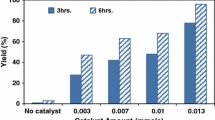Abstract
Upon gas-phase oxidative ammonolysis on vanadium oxide catalysts 4-nitro-, 2-halo, 2- and 4-hydroxy-, and 4-methoxy- and 4-phenoxytoluenes much less selectively convert into the corresponding substituted benzonitriles than their derivatives with the methyl group substituted by chloromethyl, methoxymethyl, or alkoxycarbonyl groups. This fact is explained in terms of different mechanisms of formation of the cyano group: The methyl group converts via deprotonation to form a carbanion, whereas the heteroatomic groups, via the energetically more favorable carbocation formation.
Similar content being viewed by others
REFERENCES
Suvorov, B.V., Okislitel’nyi ammonoliz organicheskih soedinenii (Oxidative Ammonolysis of Organic Compounds), Alma-Ata: Nauka, 1971.
Suvorov, B.V. and Bukeikhanov, N.R., Okislitel’nie reaktsii v organicheskom sinteze (Oxidative Reactions in Organic Synthesis), Moscow: Khimiya, 1978.
Reutov, O.A., Beletskaya, I.P., and Butin, K.P., CH-Kisloty (CH Acids), Moscow: Nauka, 1980.
Bates, R.B. and Ogle, C.A., Carbanion Chemistry, Berlin: Springer, 1983.
Krylov, O.V. and Kiselev, V.F., Adsorbtsiya i kataliz na perekhodnyh metallakh i ikh oksidakh (Adsorption and Catalysis on Transition Metals and Their Oxides), Moscow: Khimiya, 1981.
Krylov, O.V. and Berman, A.D., Usp. Khim., 1986, vol. 55, no.3, p. 371.
Golodets, G.I., in Mekhanizm kataliza: Ch. I. Priroda kataliticheskogo deistviya (Mechanism of Catalysis. Part I. Nature of Catalytic Action), Novosibirsk: Nauka, 1984, p. 142.
Sokolovskii, V.D., Catal. Rev., 1990, vol. 32, nos.1–2, p. 1.
Krylov, O.V., Kinet. Katal., 1998, vol. 39, no.3, p. 472.
Vorob’ev, P.B., Gabdullina, L.F., and Sembaev, D.Kh., Neftekhimiya, 1999, vol. 39, no.6, p. 448.
Vorob’ev, P.B., Mikhailovskaya, T.P., Gabdullina, L.F., and Sembaev, D.Kh., Zh. Obshch. Khim., 2000, vol. 70, no.8, p. 1331.
Solntsev, Yu.N., Sembaev, D.Kh., and Suvorov, B.V., Izv. Akad. Nauk KazSSR, Ser. Khim., 1969, no. 2, p. 75.
Bukeikhanov, N.R. and Suvorov, B.V., Khimiya monomerov i polimerov (Chemistry of Monomers and Polymers), Alma-Ata: Nauka, 1980, p. 3.
Suvorov, B.V., Bukeikhanov, N.R., Kudinova, V.S., and Gutsalyuk, G.N., Vestn. Akad. Nauk KazSSR, Ser. Khim., 1973, no. 3, p. 47.
Vorob’ev, P.B., Bukeikhanov, N.R., and Suvorov, B.V., Izv. Akad. Nauk KazSSR, Ser. Khim., 1978, no. 3, p. 76.
Suvorov, B.V., Bukeikhanov, N.R., and Li, L.V., Sintez i issledovanie monomerov i polimerov (Synthesis and Study of Monomers and Polymers), Alma-Ata: Nauka, 1983, p. 3.
Bukeikhanov, N.R., Li, L.V., Suvorov, B.V., Ivanov, E.V., and Maketov, A.K., Issledovanie monomerov i polimerov (Study of Monomers and Polymers), Alma-Ata: Nauka, 1986, p. 3.
Suvorov, B.V., Bukeikhanov, N.R., Li, L.V., and Zulkasheva, A.S., Zh. Prikl. Khim., 1987, no. 3, p. 677.
Suvorov, B.V., Vorob’ev, P.B., Erzhanov, A.A., and Li, L.V., Zh. Prikl. Khim., 1991, no. 1, p. 227.
Dewar, M.J.S. and Dieter, K.M., J. Am. Chem. Soc., 1986, vol. 108, no.25, p. 8075.
Clark, T., A Handbook of Computational Chemistry, New York: Wiley, 1985.
Dewar, M.J.S. and Dougherty, R.C., The PMO Theory of Organic Chemistry, New York: Plenum, 1975.
Davydov, A.A., IK spektroskopiya v khimii poverkhnosti okislov (IR Spectroscopy in the Chemistry of Oxide Surfaces), Novosibirsk: Nauka, 1984.
Suvorov, B.V., Bukeikhanov, N.R., and Li, L.V., Izv. Akad. Nauk KazSSR, Ser. Khim., 1988, no. 6, p. 51.
Author information
Authors and Affiliations
Additional information
__________
Translated from Zhurnal Obshchei Khimii, Vol. 75, No. 2, 2005, pp. 313–317.
Original Russian Text Copyright © 2005 by Vorob’ev, Sembaev.
Rights and permissions
About this article
Cite this article
Vorob’ev, P.B., Sembaev, D.K. Mechanism of Formation of the Cyano Group from the Chloromethyl, Methoxymethyl, and Alkoxycarbonyl Substituents in the Aromatic Ring Under Conditions of Oxidative Ammonolysis. Russ J Gen Chem 75, 285–289 (2005). https://doi.org/10.1007/s11176-005-0214-1
Received:
Issue Date:
DOI: https://doi.org/10.1007/s11176-005-0214-1




